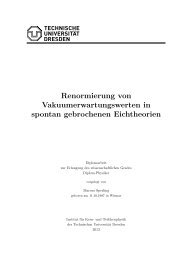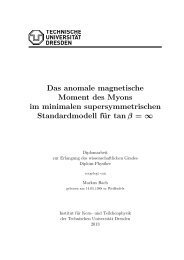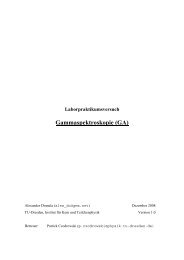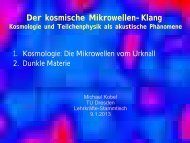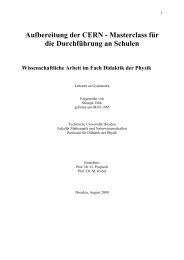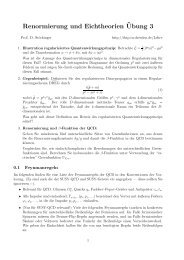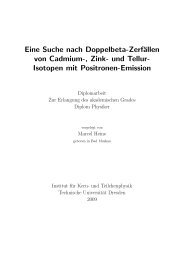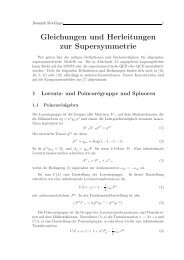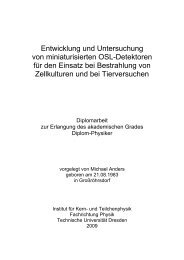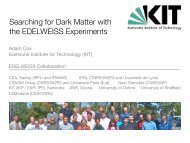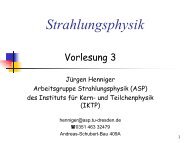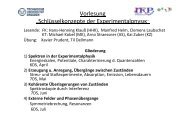a design study for a cobra upgrade to - Institut für Kern- und ...
a design study for a cobra upgrade to - Institut für Kern- und ...
a design study for a cobra upgrade to - Institut für Kern- und ...
Create successful ePaper yourself
Turn your PDF publications into a flip-book with our unique Google optimized e-Paper software.
32 4 Scintillation detec<strong>to</strong>rs<br />
activa<strong>to</strong>r should lie energetically above the valence band, but should<br />
lie low enough <strong>to</strong> maintain a high probability <strong>for</strong> hole capture. Vice<br />
versa, this applies <strong>for</strong> electrons and the energy gap between the bot<strong>to</strong>m<br />
of the conduction band and the radiation level of the doping ion. In<br />
general, the energy of the excited activa<strong>to</strong>r state should be smaller than<br />
the bandgap energy Eg <strong>to</strong> prevent self-absorption of the scintillation<br />
light by the host lattice.<br />
Instead of exciting luminescence centres, the electrons, holes and exci<strong>to</strong>ns<br />
can be bo<strong>und</strong> by traps. These are metastable levels from which the<br />
charge carriers may subsequently return <strong>to</strong> the conduction band by acquiring<br />
thermal energy from the lattice vibrations or fall <strong>to</strong> the valence<br />
band by a radiationless transition.<br />
Q is the luminescence quantum yield, which is the efficiency <strong>for</strong> the luminescence<br />
emission of an activated luminescence centre and depends<br />
on the kind of excited state of a luminescence centre.<br />
Scintillation yields can be a few thousand <strong>to</strong> much more than 60.000<br />
pho<strong>to</strong>ns per deposited MeV <strong>for</strong> efficient scintilla<strong>to</strong>rs [26, 27].<br />
The amount of produced pho<strong>to</strong>ns varies and leads <strong>to</strong> an intrinsic scintilla<strong>to</strong>r<br />
resolution. The variation results from three fac<strong>to</strong>rs. There is a<br />
nonproportionality of the number of emitted pho<strong>to</strong>ns <strong>to</strong> the incident<br />
energy. The importance of this fac<strong>to</strong>r depends on the scintilla<strong>to</strong>r material<br />
and the considered energy region. Also, the electronic excitations<br />
of various energies lead <strong>to</strong> a distribution of light yields, which increase<br />
the energy resolution. Additionally, local variations of the light yield<br />
are caused by inhomogeneity of the crystal.<br />
DECAY TIME<br />
The time characteristic of the scintilla<strong>to</strong>r is determined by the half-life<br />
characteristic of the excited states. Mostly, the migration time does<br />
not influence the time characteristic, because it is much shorter than<br />
the half-life. The impurity configurations are <strong>for</strong>med essentially after<br />
10 −12 -10 −8 sec and then de-excite with the corresponding half-life of<br />
typically 50-500 ns. Inorganic scintilla<strong>to</strong>rs can have more than one decay<br />
time, originating from different excitations of luminescence centres.<br />
In general, the time evolution of the luminescence emission can be described<br />
by one or two exponential decay <strong>for</strong>ms [26, 27, 28, 29].<br />
TEMPERATURE DEPENDENCE<br />
The light output of scintilla<strong>to</strong>rs also depends on temperature. While<br />
organic scintilla<strong>to</strong>rs have a temperature independent light output, the<br />
light output of inorganic scintilla<strong>to</strong>rs can vary strongly with temperature.<br />
As shown in figure 4.5 NaI:Tl has a stable light output between 20<br />
and 40 ◦ C, increasing with higher and lower temperature. Bi4Ge3O12



